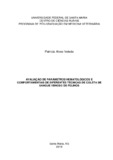| dc.creator | Veleda, Patrícia Alvez | |
| dc.date.accessioned | 2019-04-09T15:36:43Z | |
| dc.date.available | 2019-04-09T15:36:43Z | |
| dc.date.issued | 2018-11-14 | |
| dc.identifier.uri | http://repositorio.ufsm.br/handle/1/16119 | |
| dc.description.abstract | Exams laboratory have as function main auxiliary in the diagnosis, together with the physical exam and the patient's clinical history. In that context, it is indispensable that the collection of blood is accomplished in a correct way for not interfering in their results. The puncturing the jugular vein is the technique more used in the clinical routine for the collection of blood in felines. However, for most of the felines, that technique is uncomfortable and stressful. The main consequence resulting from the stress during the collection of blood, in that species, is the appearance of alterations of hematological parameters, as the platelet aggregation, that a lot of times make unfeasible the analysis needs the exam. So, a technique used in human pediatrics was adapted for the collection blood in felines, with the objective of minimizing the stress and, like this, to prevent the formation of attachés platelet during the sampling of blood. For that, they were selected, for collection of sanguine samples, 110 felines healthy of any sex, race, age and weight. The animals were distributed randomly in two groups, being them GCJ (group jugular collection) and GCG (group collects dripping), both with 55 animals. It was collected 2ml of blood, or by puncture of the right jugular vein with syringe of 3ml and needle 25x8 in the group GCJ or by insert of outlying veined catheter 22G in the right cephalic vein in the group GCG. The volume of 0,5mL of blood was conditioned in tube containing ethylenediaminetetraacetic acid (EDTA) and 1,5ml in tubes without anticoagulants. The analyzed parameters were complete blood count, blood glucose, bruise formation in the place of the puncture, occurrence of aggregation platelet and stress score. The results showed that the platelet aggregation and the stress score were smaller statistically in GCG. The technique of collection of blood by dripping of the cephalic vein of felines was shown more appropriate for the feline species for to minimize the stress behavioral and to reduce the occurrence of platelet aggregation without altering the other hematological parameters. | eng |
| dc.language | por | por |
| dc.publisher | Universidade Federal de Santa Maria | por |
| dc.rights | Attribution-NonCommercial-NoDerivatives 4.0 International | * |
| dc.rights.uri | http://creativecommons.org/licenses/by-nc-nd/4.0/ | * |
| dc.subject | Agregação plaquetária | por |
| dc.subject | Estresse | por |
| dc.subject | Hemograma | por |
| dc.subject | Gato | por |
| dc.subject | Platelet aggregation | eng |
| dc.subject | Stress | eng |
| dc.subject | Blood count | eng |
| dc.subject | Cat | eng |
| dc.title | Avaliação de parâmetros hematológicos e comportamentais de diferentes técnicas de coleta de sangue venoso de felinos | por |
| dc.title.alternative | Evaluation of hematological and behavioral parameters of different techniques of collection of venous blood of felines | eng |
| dc.type | Dissertação | por |
| dc.description.resumo | Exames laboratoriais têm como função principal auxiliar no diagnóstico, juntamente com o exame físico e a história clínica do paciente. Nesse contexto, é indispensável que a coleta de sangue seja realizada de forma correta para não interferir em seus resultados. A venopunção jugular é a técnica mais utilizada na rotina clínica para a coleta de sangue em felinos. Porém, para a maior parte dos felinos, essa técnica é incômoda e estressante. A principal consequência resultante do estresse durante a coleta de sangue, nessa espécie, é o surgimento de alterações de parâmetros hematológicos, como a agregação plaquetária, que muitas vezes inviabilizam a análise precisa do exame. Diante disso, uma técnica utilizada em pediatria humana foi adaptada para a coleta sangue em felinos, com o objetivo de minimizar o estresse e, assim, prevenir a formação de agregados plaquetários durante a amostragem de sangue. Para isso, foram selecionados, para coleta de amostras sanguíneas, 110 felinos hígidos de qualquer sexo, raça, idade e peso. Os animais foram distribuídos aleatoriamente em dois grupos, sendo eles o GCJ (grupo coleta jugular) e GCG (grupo coleta gotejamento), ambos com 55 animais. Foi coletado 2ml de sangue, ou por punção da veia jugular direita com seringa de 3ml e agulha 25x8 no grupo GCJ ou por inserção de cateter venoso periférico 22G na veia cefálica direita no grupo GCG. O volume de 0,5mL de sangue foi acondicionado em tubo contendo ácido etileno diaminotetracético (EDTA) e 1,5ml em tubos sem anticoagulantes. Os parâmetros analisados foram hemograma completo, glicemia, formação de hematoma no local da punção, ocorrência de agregação plaquetária e escore de estresse. Os resultados mostraram que a agregação plaquetária e o escore de estresse foram estatisticamente menores no GCG. A técnica de coleta de sangue por gotejamento da veia cefálica de felinos mostrou-se mais apropriada para a espécie por minimizar o estresse comportamental e diminuir a ocorrência de agregação plaquetária sem alterar os demais parâmetros hematológicos. | por |
| dc.contributor.advisor1 | Andrade, Cinthia Melazzo de | |
| dc.contributor.advisor1Lattes | http://lattes.cnpq.br/2886709251370905 | por |
| dc.contributor.advisor-co1 | Bueno, Andressa | |
| dc.contributor.advisor-co1Lattes | http://lattes.cnpq.br/4870571413044992 | por |
| dc.contributor.referee1 | Pinto Filho, Saulo Tadeu Lemos | |
| dc.contributor.referee1Lattes | http://lattes.cnpq.br/1626744106896196 | por |
| dc.contributor.referee2 | Wolkmer, Patricia | |
| dc.contributor.referee2Lattes | http://lattes.cnpq.br/5142205719893657 | por |
| dc.creator.Lattes | http://lattes.cnpq.br/2979415863191898 | por |
| dc.publisher.country | Brasil | por |
| dc.publisher.department | Medicina Veterinária | por |
| dc.publisher.initials | UFSM | por |
| dc.publisher.program | Programa de Pós-Graduação em Medicina Veterinária | por |
| dc.subject.cnpq | CNPQ::CIENCIAS AGRARIAS::MEDICINA VETERINARIA | por |
| dc.publisher.unidade | Centro de Ciências Rurais | por |



